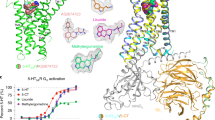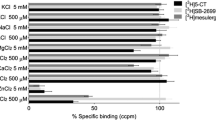A leading role in the interactions of most serotonin-type hormone receptors with heterotrimeric G proteins is played by their third cytoplasmic loops. Studies in recent years have shown that synthetic peptides corresponding to the membrane-proximal parts of these loops may have selective influences on the transmission of hormone signals via their homologous receptors and trigger the signal cascade in the absence of hormone. We report the first synthesis of peptides derived from the C-terminal region of the third cytoplasmic loop of type 1B serotonin receptors, along with studies of their influences on the serotonin sensitivity of the adenylate cyclase system in the rat brain. Peptides 300–316 and 306–316 (numbered from amino acid positions in the rat serotonin subtype 1B receptor molecule) at micromolar concentrations, in the absence of hormone, stimulated GTP-binding Gi-proteins coupled with subtype 1B serotonin receptors and inhibited forskolin-stimulated adenylate cyclase activity. Studies using selective serotonin receptor agonists and antagonists showed that peptides 300–316 and 306–316 inhibit the transmission of the serotonin signal via the homologous receptor but have weak effects on other types of serotonin receptor. Peptide 300–316 were markedly more active than its shortened analog 306–316 in terms of the selectivity and efficacy of actions on the adenylate cyclase signaling system, which is regulated via subtype 1B serotonin receptors. These data provide evidence that region 300–316 of subtype 1B serotonin receptors is involved in the interaction with Gi proteins and includes the main molecular determinants responsible for transmission of the serotonin signal to adenylate cyclase.
Similar content being viewed by others
References
A. O. Shpakov, “Molecular determinants of receptors and GTP-binding proteins determining the specificity of interactions between them,” Zh. Evolyuts. Biokhim. Fiziol., 32, No. 4, 488–511 (1996).
A. O. Shpakov, “Molecular determinants in receptors of the serpantane type responsible for their functional coupling with heterotrimeric G-proteins,” Tsitologiya, 44, No. 3, 242–258 (2002).
A. O. Shpakov, “Involvement of charged amino acid residues of the cytoplasmic loop of receptors of the serpantane type in the transmission of hormone signals,” Zh. Evolyuts. Biokhim. Fiziol., 39, No. 3, 205–217 (2003).
A. O. Shpakov, “Polycationic peptides as nonhormonal regulators of signal systems,” Zh. Evolyuts. Biokhim. Fiziol., 45, No. 4, 355–367 (2009).
A. O. Shpakov, “Structural-functional characteristics of neuronal serotonin receptors and the molecular mechanisms of their functional coupling with G-proteins,” Neirokhimiya, 26, No. 1, 1–14 (2009).
A. O. Shpakov, I. A. Guryanov, I. A. Kuznetsova, S. A. Plesneva, E. A. Shpakova, G. P. Vlasov, and M. N. Pertseva, “Studies of the molecular mechanisms of action of relaxin on the adenylate cyclase signal system using synthetic peptides derived from the relaxin receptor LGR7,” Ros. Fiziol. Zh. im. I. M. Sechenova, 92, No. 5, 521–535 (2006).
A. O. Shpakov, I. A. Guryanov, I. I. Tarasenko, and G. P. Vlasov, “The effects of polycationic peptides of different types on the functional state of the serotonin-regulated adenylate cyclase signal system in the rat brain,” Neirokhimiya, 26, No. 4, 310–320 (2009).
A. O. Shpakov, M. N. Pertseva, I. A. Guryanov, and G. P. Vlasov, “The effects of peptides derived from the third cytoplasmic loop of the relaxin type 1 receptor on the relaxin-stimulated GTP-binding activity of G-proteins,” Biol. Membr., 22, No. 6, 435–442 (2005).
A. O. Shpakov, I. I. Tarasenko, and E. A. Shpakova, “Peptides derived from the third cytoplasmic loop of the serotonin type 6 receptor as regulators of the serotonin-sensitive adenylate cyclase signal system,” Dokl. Ros. Akad. Nauk., 431, No. 5, 703–706 (2010).
T. Adayev, B. Ranasinghe, and P. Banerjee, “Transmembrane signaling in the brain by serotonin, a key regulator of physiology and emotion,” Biosci. Rep., 25, 363–385 (2005).
G. Bellot, S. Granier, W. Bourguet, R. Seyer, R. Rahmeh, B. Mouillac, R. Pascal, C. Mendre, and H. Demene, “Structure of the third intracellular loop of the vasopressin V2 receptor and conformational changes upon binding to gC1qR,” J. Mol. Biol., 388, No. 3, 491–507 (2009).
J. Bockaert, S. Claeysen, C. Becamel, A. Dumuis, and P. Marin, “Neuronal 5-HT metabotropic receptors: fine-tuning of their structure, signaling, and roles in synaptic modulation,” Cell Tiss. Res., 326, 553–572 (2006).
L. Covic, M. Misra, J. Badar, C. Singh, and A. Kuliopulos, “Pepducinbased intervention of thrombin-receptor signaling and systemic platelet aggregation,” Nat. Med., 8, 1161–1165 (2002).
E. Del Olmo, J. F. Lopez-Gimenez, M. T. Vilaro, G. Mengod, J. M. Palacios, and A. Pazos, “Early localization of mRNA coding for 5-HT1A receptors in human brain during development,” Mol. Brain Res., 60, 123–126 (1998).
P. Gaspar, O. Cases, and L. Maroteaux, “The developmental role of serotonin: news from mouse molecular genetics,” Nat. Rev. Neurosci., 4, 1002–1012 (2003).
J. A. Gingrich and R. Hen, “Dissecting the role of the serotonin system in neuropsychiatric disorders using knockout mice,” Psychopharmacology, 155, 1–10 (2001).
B. Konig and M. Gratzel, “Site of dopamine D1 receptor binding to Gs protein mapping with synthetic peptides,” Biochem. Biophys. Acta, 1223, 361–266 (1994).
S. Kubo, T. Ishiki, I. Doe, F. Sekiguchi, H. Nishigawa, K. Kawai, H. Matsui, and A. Kawabata, “Distinct activity of peptide mimetic intracellular ligands (pepducins) for proteinase-activated receptor-1 in multiple cells/tissues,” Ann. N.Y. Acad. Sci., 1091, 445–459 (2006).
A. Malmberg and P. G. Strange, “Site-directed mutations in the third intracellular loop of the serotonin 5-HT1A receptor alter G-protein coupling from Gi to Gs in a ligand-dependent manner,” J. Neurochem., 75, 1283–1293 (2000).
G. Megaritis, M. Merkouris, and Z. Georgoussi, “Functional domains of δ- and μ-opioid receptors responsible for adenylyl cyclase inhibition,” Receptors Channels, 7, 199–212 (2000).
M. J. Millan, A. Gobert, V. Audinot, A. Dekeyne, and A. Newman- Tancredi, “Inverse agonists and serotoninergic transmission: from recombinant human serotonin (5-HT)1B receptors G-protein coupling and function in corticolimbic structures in vivo,” Neuropsychopharmacology, 21, 61–67 (1999).
S. Mukhopadhyay and A. C. Howlett, “CB1 receptor-G-protein association: subtype selectivity is determined by distinct intracellular domains,” Eur. J. Biochem., 268, 499–505 (2001).
G. Munch, C. Dees, M. Heckman, and D. Palm, “Multisite contacts involved in coupling of the β-adrenergic receptor with the stimulatory guanine-nucleotide-binding regulatory protein: structural and functional studies by β-receptor-site-specific synthetic peptides,” Eur. J. Biochem., 198, 357–364 (1991).
Y. Odagaki, N. Nishi, and T. Koyama, “Effects of the wasp venom peptide, mastoparan, on GTP hydrolysis in rat brain membranes,” Brit. J. Pharmacol., 121, 1406–1412 (1997).
T. C. Ortiz, M. C. Devereaux, and K. K. Parker, “Structural variants of a human 5-HT1a receptor intracellular loop 3 peptide,” Pharmacology, 60, 195–202 (2000).
P. J. Pauwels, A. Gouble, and T. Wurch, “Activation of constitutive 5- hydroxytryptamine1B receptor by a series of mutations in the BBXXB motif: positioning of the third intracellular loop distal junction and its G0α protein interactions,” Biochem. J., 343, 436–442 (1999).
T. J. Pucadyil, S. Kalipatnapu, and A. Chattopadhyay, “The serotonin1A receptor: a representative member of the serotonin receptor family,” Cell. Mol. Neurobiol., 25, 553–580 (2005).
H. Shirai, K. Takahashi, K. T. Katada, and T. Imagami, “Mapping of G protein coupling sites of the angiotensin II type 1 receptor,” Hypertension, 25, 726–730 (2005).
A. O. Shpakov, L. A. Kuznetsova, S. A. Plesneva, A. P. Kolychev, V. M. Bondareva, O. V. Chistyakova, and M. N. Pertseva, “Functional defects in adenylyl cyclase signaling mechanisms of insulin and relaxin action in skeletal muscles of rat with streptozotocin type 1 diabetes,” Cent. Eur. J. Biol., 1, 530–544 (2006).
A. O. Shpakov and M. N. Pertseva, “The peptide strategy as a novel approach to the study of G protein-coupled signaling systems,” in: Signal Transduction Research Trends, N. O. Grachevsky (ed.), Nova Science Publishers, Hauppage, New York (2007), pp. 45–93.
H. V. Thiagarah, T. C. Ortiz, M. C. Devereaux, B. Seaver, B. Hall, and K. K. Parker, “Regulation of G-proteins by human 5-HT1A receptor TM3/i2 and TM5/i3 loop particles,” Neurochem. Int., 50, 109–118 (2007).
Author information
Authors and Affiliations
Corresponding author
Additional information
Translated from Rossiiskii Fiziologicheskii Zhurnal imeni I. M. Sechenova, Vol. 96, No. 11, pp. 1062–1074, November, 2010.
Rights and permissions
About this article
Cite this article
Shpakov, A.O., Shpakova, E.A., Tarasenko, I.I. et al. Peptides Derived from the Third Cytoplasmic Loop of the Serotonin Subtype 1B Receptor Selectively Inhibit Transmission of Serotoninergic Signals via Their Homologous Receptors. Neurosci Behav Physi 42, 285–292 (2012). https://doi.org/10.1007/s11055-012-9564-4
Received:
Published:
Issue Date:
DOI: https://doi.org/10.1007/s11055-012-9564-4




